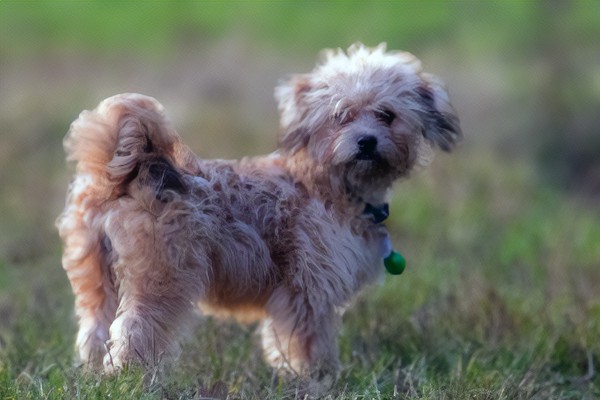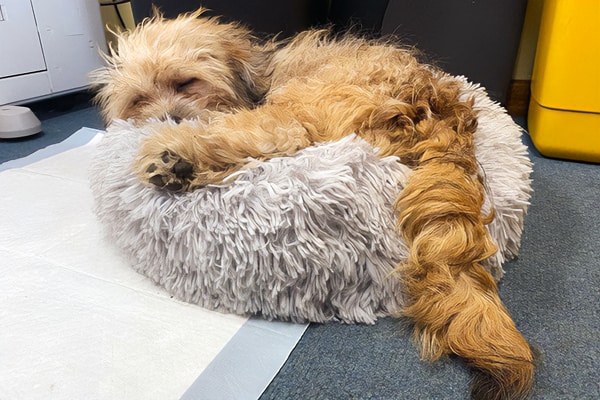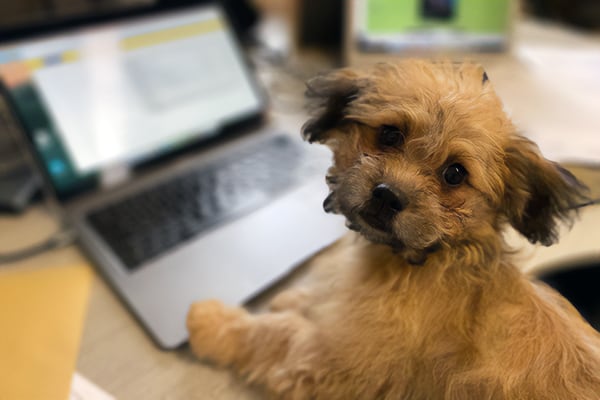The presence of a therapy dog and targeted
SIAMS inspection report 2025
provision for vulnerable pupils have a clear and positive impact on wellbeing and confidence.
Introducing Nala
Nala is our school dog. She came to work with us as a puppy in the autumn term of 2023 and is still in training (weekly formal training sessions, as well as care and support in school). When she isn’t in school Nala lives with Dr Foster who is her legal owner and is responsible for her.
Nala is a cross between a Shih Tzu/Pomeranian and a Shih Tzu/Bichon Frise. All three breeds have excellent qualities for a school dog. Nala shows all the expected characteristics of her type: she’s lively, gentle, inquisitive and playful, very open and adaptable, and welcoming of people she doesn’t know. She’s also small, cute, soft and fluffy, but with a coat which doesn’t shed and is hypoallergenic (it’s very rare for anyone to be allergic to any of these breeds).
Although Nala is as safe as a dog can be, we never take it for granted that there won’t be any problems. Before Nala arrived we carried out an extensive risk assessment, including gathering information from other schools which already have school dogs or regular visiting dogs on site. We also have a new policy document which sets down exactly how we manage both Nala and any other animals which may from time to time come onto the school site for educational purposes. You can read our policy by following the link below. If reading the policy doesn’t answer all your questions, please get in touch.
Nala’s behaviour in school and her temperament have also been independently assessed by a Home Office Approved Dog Instructor, who has a Diploma in Dog Psychology as well as a Level 3 Advanced Btec in search dog handling and has qualified as a Master Dog Trainer. You can read Nala’s assessment report by following the link below.


How Nala works in school
Nala’s first role in the school is to promote well-being. Research has shown that there are many benefits from having a suitable dog in school on a regular basis. School dogs improve pupil behaviour and attendance as well as increasing their understanding of caring for and taking responsibility for an animal and enhancing their empathy and nurturing skills. Animal assisted interventions can:
- Teach empathy and appropriate interpersonal skills
- Help individuals develop social skills
- Be soothing and decrease anxiety
- Improve a child’s ability to pick up on social cues
- Support emotional regulation
- Improve motivation for learning
- Improve confidence and self-esteem
- Teach responsibility and respect for all life
As well as improving pupil’s overall well-being, Nala will also work as a reading dog. Reading programmes with dogs are known to boost achievement, particularly for pupils who find reading a struggle and are reluctant to read out loud. Research has proved that pupils who read to dogs show an increase in reading levels and word recognition, and a higher desire to read and write. Dogs make wonderful listeners and never judge or correct, so they encourage pupils to practise reading aloud.
Frequently asked questions
You can find the answers to most of your questions by reading our animals in school policy (see the link above), but here are brief answers to some of the most frequently asked questions. If you need to know more or would like to raise any concerns, please do get in touch.
Q: Who is the legal owner of the dog and who pays for its costs?
A: The legal owner of the dog is Dr Foster and he will bear the costs associated with owning the dog; the school budget will support insurance to cover her role in school.
Q: Has a risk assessment been undertaken?
A: Yes, a full risk assessment is in place, which will be reviewed regularly. We have carefully considered having a dog in school and sought advice from many sources, including other schools that successfully have a school dog.
Q: Have issues of hygiene been considered?
A: The dog is taken regularly for toiletting to an area of the school grounds to which children have no access and this area is cleared of any ‘deposits’. In school we have strict rules about washing hands after contact.
Q: How is the dog’s welfare ensured?
A: The dog is taken outside regularly through the day. She has her own safe space away from the children where she can rest, and she has access to food and water. We have strict rules for pupil interaction with the dog and there is constant adult supervision. Contact time with children is carefully managed and limited so that the dog is never stressed or tired.
Q: What happens about allergies?
A: We already manage a number of allergies and the possiblity of an allergy to dogs will be managed in the same way. We are happy to work with parents to put additional control measures in place for individual allergies. Nala is a type of dog to which few people have an allergic reaction (people who are allergic to some dogs often find they have no problem with dogs like Nala whose coats produce very little dander). However, no child is required to work with Nala.
Q: My child is frightened of dogs. How will you manage this?
A: Access to the dog will be carefully managed and supervised and children do not need to have close contact with Nala if their parents have asked us to ensure this. No child will have dog therapy sessions without parental consent. We hope to work closely with parents of children who are fearful of dogs to help alleviate their fear and to teach them how to manage this.

This page was last updated on 21st January 2025
